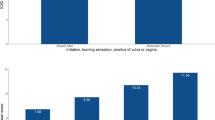Abstract:
For 285 subjects referred to a menopause clinic data were prospectively collected on the time elapsed since the onset of menopause (menopausal age), sexual activity, dyspareunia, smoking, chronic cough and constipation. Prolapse and atrophy were sought on examination. FSH assay confirmed menopausal status. We found an anterior wall prolapse in 51% of the subjects, of which 6% were protruding beyond the introitus. Posterior wall prolapse was present in 27% and apical prolapse in 20%; none was protruding beyond the introitus. No trend was noted between prolapse and menopausal age. Atrophy was evident in 34% of the women, and this was related to menopausal age (P<0.001). Forty per cent of the sexually active women admitted to dyspareunia, of which 2/3 were superficial. This correlated with advancing menopausal age (P<0.02). In conclusion, genital prolapse was frequent in the population of postmenopausal women, predominantly cystocele, but the prevalence did not correlate with menopausal age.
Similar content being viewed by others
Author information
Authors and Affiliations
Rights and permissions
About this article
Cite this article
Versi, E., Harvey, MA., Cardozo, L. et al. Urogenital Prolapse and Atrophy at Menopause: A Prevalence Study. Int Urogynecol J 12, 107–110 (2001). https://doi.org/10.1007/s001920170074
Published:
Issue Date:
DOI: https://doi.org/10.1007/s001920170074




